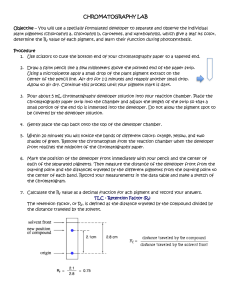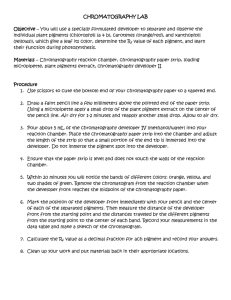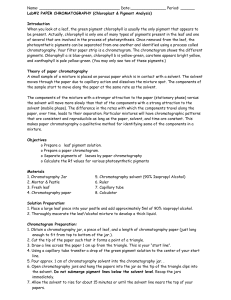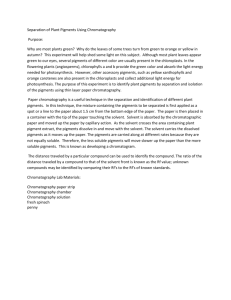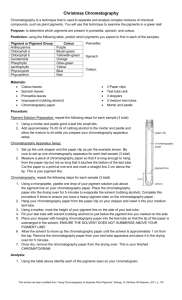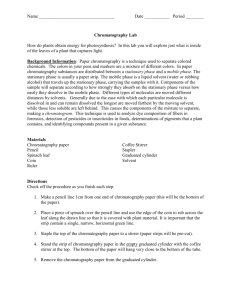CHROMATOGRAPHY OF PHOTOSYNTHETIC PIGMENTS
advertisement
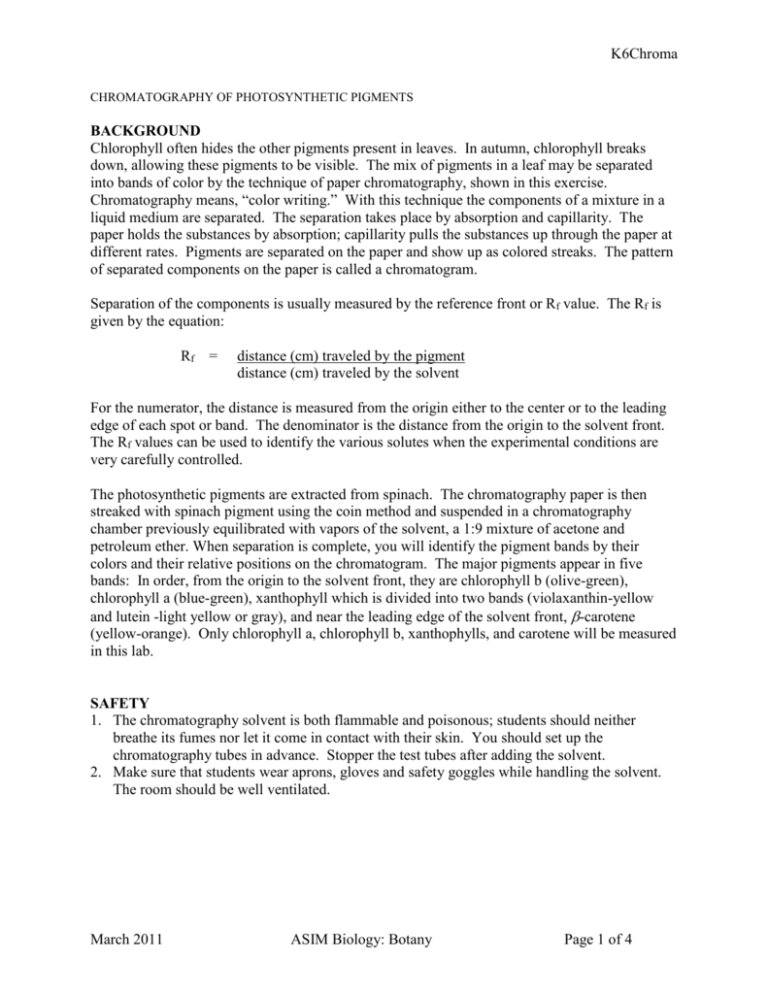
K6Chroma CHROMATOGRAPHY OF PHOTOSYNTHETIC PIGMENTS BACKGROUND Chlorophyll often hides the other pigments present in leaves. In autumn, chlorophyll breaks down, allowing these pigments to be visible. The mix of pigments in a leaf may be separated into bands of color by the technique of paper chromatography, shown in this exercise. Chromatography means, “color writing.” With this technique the components of a mixture in a liquid medium are separated. The separation takes place by absorption and capillarity. The paper holds the substances by absorption; capillarity pulls the substances up through the paper at different rates. Pigments are separated on the paper and show up as colored streaks. The pattern of separated components on the paper is called a chromatogram. Separation of the components is usually measured by the reference front or Rf value. The Rf is given by the equation: Rf = distance (cm) traveled by the pigment distance (cm) traveled by the solvent For the numerator, the distance is measured from the origin either to the center or to the leading edge of each spot or band. The denominator is the distance from the origin to the solvent front. The Rf values can be used to identify the various solutes when the experimental conditions are very carefully controlled. The photosynthetic pigments are extracted from spinach. The chromatography paper is then streaked with spinach pigment using the coin method and suspended in a chromatography chamber previously equilibrated with vapors of the solvent, a 1:9 mixture of acetone and petroleum ether. When separation is complete, you will identify the pigment bands by their colors and their relative positions on the chromatogram. The major pigments appear in five bands: In order, from the origin to the solvent front, they are chlorophyll b (olive-green), chlorophyll a (blue-green), xanthophyll which is divided into two bands (violaxanthin-yellow and lutein -light yellow or gray), and near the leading edge of the solvent front, -carotene (yellow-orange). Only chlorophyll a, chlorophyll b, xanthophylls, and carotene will be measured in this lab. SAFETY 1. The chromatography solvent is both flammable and poisonous; students should neither breathe its fumes nor let it come in contact with their skin. You should set up the chromatography tubes in advance. Stopper the test tubes after adding the solvent. 2. Make sure that students wear aprons, gloves and safety goggles while handling the solvent. The room should be well ventilated. March 2011 ASIM Biology: Botany Page 1 of 4 K6Chroma MATERIALS Chromatography Solution (1 acetone: 9 petroleum ether) Stopper calculator Pipette scissors chromatography paper spinach leaves (or other leaf type) colored pencils test tube holder coin ruler chromatography chamber (15 cm or larger test tube or flat bottom culture tube, stopper, thumb tack or paper clip) PROCEDURE 1. Cut a strip of chromatography paper so that it just fits inside a chromatography chamber. Cut a point at one end. 2. Draw a faint pencil line about 4 cm from the pointed end of the paper strip. 3. Place the stopper on the chamber and hold the paper strip next to the chamber with the pointed end about 1 cm from the bottom of the chamber. Bend the top end of the paper where the bottom of the stopper is inside the chamber. Remove the stopper and attach the paper strip to the bottom using a thumb tack or paper clip. Reassemble the chromatography chamber making sure the paper strip is 1 cm from the bottom once it is stoppered. 4. Remove the chromatography paper from the stopper and apply the plant pigment using a coin method--Hold the coin between your thumb and index finger and position the leaf over the pencil line. Roll the edge of the coin over the leaf while pressing down firmly, but not so hard that the paper is torn. A green line should have been left across the pencil line. Repeat as many as 20 times, allowing the pigment to dry between applications. 5. Pour chromatography solution into the test tube to fill it to about 1 cm. After completing the pigment application, attach the paper strip to the stopper and suspend it in the chamber containing the chromatography solvent. The tip of the paper should just be touching the top of the solvent as in Figure 1. March 2011 ASIM Biology: Botany Page 2 of 4 K6Chroma 6. Put the chamber in the test tube holder and leave it undisturbed until the separation of pigments is complete. When 3 – 5 pigment bands are visible or the solvent front is within 2.5 cm of the stopper, remove the chromatography paper from the test tube. 7. Place the chromatograph on a paper towel and immediately mark the top of the solvent line with a pencil. This is the point at which the paper no longer looks wet. Next mark the center of each pigment band by making a dot with your pencil. 8. Observe the bands of pigment. Record the colors in Table 1 of the Student Data Sheet. 9. Make a drawing of your chromatogram in Figure 2 on the data sheet using the colored pencils. 10. Measure the distance (cm) traveled by the solvent and the distance traveled by each pigment (measured from the starting line to the dot at the center of each pigment band). Record these values in Table 1. 11. Calculate and record the Rf for each pigment, then record the pigment names in Table 1 of the Student Data Sheet. March 2011 ASIM Biology: Botany Page 3 of 4 K6Chroma STUDENT ANSWER SHEET Name: ____________________________ CHROMATOGRAPHY OF PHOTOSYNTHETIC PIGMENTS DATA Figure 2. Drawing of chromatogram Date: ____________________________ Table 1. Chromatogram Data Leaf type: Distance solvent traveled (cm): Pigment color Distance pigment traveled (cm) Rf value Pigment Name Rf = distance (cm) traveled by the pigment distance (cm) traveled by the solvent ANALYSIS 1. Could the presence of different pigments be detected before separation by chromatography? 2. Use the width of the band as an indication of the amount of pigment present. Which pigment is present in the greatest amount? Which is present in the least amount? 3. How does the amount and color of each pigment in a leaf explain why leaves are usually green? 4. What is the specific role of chlorophyll a and chlorophyll b in a leaf? 5. Many leaves appear to change color in the autumn. How is it possible for this to happen? March 2011 ASIM Biology: Botany Page 4 of 4

